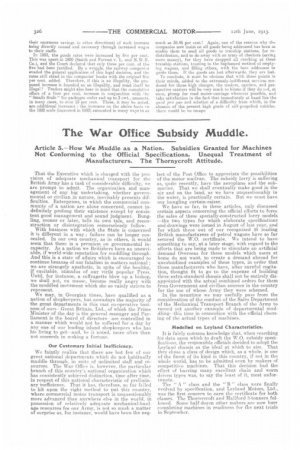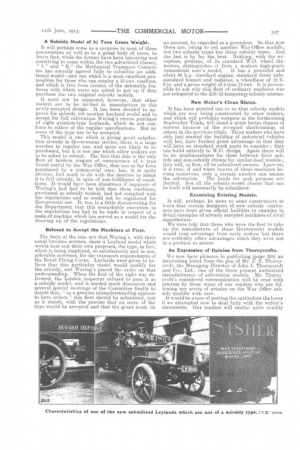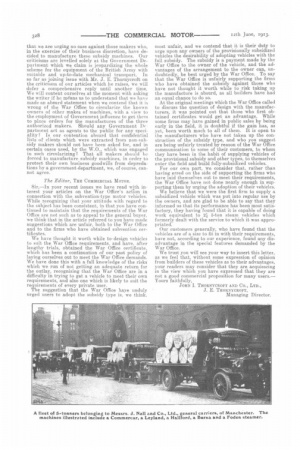The War Office Subsidy Muddle.
Page 4

Page 5

Page 6

If you've noticed an error in this article please click here to report it so we can fix it.
Article 3.—How We Muddle as a Nation. Subsidies Granted for Machines Not Conforming to the Official Specifications. Unequal Treatment of Manufacturers. The Thornycroft Attitude.
That the Executive which is charged with the provision of adequate mechanical transport for the British Army has a task of considerable difficulty, we are prompt to admit. The organization and management of any big undertaking, whether governmental or civilian in nature, inevitably presents difficulties. Enterprises, in which the commercial community of a nation are alone concerned, cannot indefinitely prolong their existence except by consistent good management and sound judgment. Bungling, sooner or later, tells its own tale, and reconstruction or disintegration remorselessly follow.
With business with which the State is concerned It is different in a way ; failure can be longer concealed. In our own country, as in others, it would seem that there is a premium on governmental incapacity. As a nation we Britishers have an unenviable, if world-wide reputation for muddling through. And this is a state of affairs winch is encouraged to continue because of our fatalism in matters national ; we are strangely apathetic, in spite of the healthy, if excitable, stimulus of our virile popular Press. Until, for instance, a suffragette blow up a bishop, we shall not, en masse, become really angry with the muddled movement, which she so vainly strives to represent.
We may, in Georgian times, have qualified as a nation of shopkeepers, but nowadays the majority of the great departments in this vast co-operative business of ours--Great Britain, Ltd., of which the Prime Minister of the day is the general manager and Parliament is the board of directorsare controlled in a manner which would not be suffered for a. day by any one of our leading island shopkeepers who has his living to get—and, be it noted, snore often than not succeeds in making a fortune.
Our Customary Initial Inelficiency.
We faintly realize that there are but few of our great national departments which do not habitually muddle through, in spite of unlimited staff and resources. The War Office is, however, the particular branch of this country's national organization which has consistently achieved distinction, time after tune, in respect of this national characteristic of preliminary inefficiency. That. it has, therefore, so far failed to hit upon the right method to nut this country, where commercial motor transport is unquestionably more advanced than anywhere else in the world, in possession of relatively adequate mechanical-haulage resources for our Army, is riot so much a matter of surprise as, for instance, would have been the neg lect of the Post Office to appreciate the possibilities of the motor mailvare The subsidy lorry is suffering as, quite recently, have the aeroplane and the submarine. That we shall eventually make good in the air and on the land, as we have unquestionably in the water, is practically certain. But we must have our bungling curtain-raiser. We have so far, in these articles, only discussed certain aspects concerning the official efforts to force the sales of these specially-constructed lorry models —the two types for which elaborate specifications and drawings were issued in August of last year, and for which three out of our recognized 28 leading British manufacturers of petrol wagons have so far secured the W.O. certificate. We intend to have something to say, at a later stage, with regard to the efforts that are being made to stimulate an artificial demand Overseas for these models which users at home do not want, to create a demand abroad for unsubsidized examples of these types, in order that those manufacturers who have, after careful cogitation, thought fit to goto the expense of building these extra-standard chassis shall not be entirely disappointed with the actual combined orders for them from Government and civilian sources in the country for the use of whose Army they were schemed.
In the meantime we may usefully pass from the consideration of the conduct of the Sales Department of the Mechanical Transport Branch of the Army to record yet another example of departmental muddling--this time in connection with the official choosing of the actual types of machines.
Modelled on Leyland Characteristics.
It is fairly common knowledge that, when searching for data upon which to draft the W.O. subsidy specifications, the responsible officials decided to adopt the Leyland chassis as the ideal at which to aim. That they chose a class of design which, as a whole, is one of the finest of its kind in this country, if not in the whole world, has to be admitted even by makers of competitive machines. That this decision had the effect of barring many excellent chain and worm driven types was, to say the least of it, most unfortunate.
The " A " class and the "B" class were finally evolved by specification, and Leyland Motors, Ltd., was the first concern to earn the certificate for both classes. The Thornveroft and Hallford 3-tonners followed. SOME half-dozen other makers are now busy eormeleting machines in readiness for the next trials in September. A Subsidy Model of 5f Tons Gross Weight.
It will perhaps come as a surprise to most of these constructors as well as to a great body of users, to learn that, while the former have been labouring and contriving to come within the two advertised classes, " A " and "B," the Mechanical Transport Committee has actually agreed fully to subsidize an additional model—and one which is a most excellent proposition for those who can employ a 50-cwt. machine, and which is free from certain of the debatable features with which users are asked to put up if they purchase the two original subsidy models.
It must not be supposed, however, that other makers are to be invited to manufacture to this newly-accepted design. It has been decided to approve for subsidy yet another Leyland model and to accept for full subvention Waring's recent purchase of eight aviation-type Leylands, which do not conform to either of the regular specifications. But no more of the type are to be accepted. This model is one which is giving great satisfaction already in Government service, there is a large number in regular use, and more are likely to be purchased, but, it is not one which other makers are to be asked to submit. The fact that this is the only fleet of modern wagons of consequence of a type found useful by the War Office, that has so far been purchased by a commercial user, has, it is quite obvious, had much to do with the decision to admit it to full subsidy, in spite of non-fulfilment of conditions. It would have been disastrous if inquirers of Waring's had had to be told that these machines, purchased as subsidy models, had not complied with the regulations and so could not be registered for Government use. It, too, is a little disconcerting for the Department that this remarkable exception to the regulations has had to be made in respect of a make of machine which has served as a model for the (hawing up of the regulations.
Refused to Accept the Machines at First.
The facts of the case are that Waring's, with their usual business acumen, chose a Leyland model which would best suit their own purposes, the type, in fact, which is being employed, so satisfactorily and in considerable numbers, for the transport requirements of the Royal Flying Corps. Leylands were given to believe that this particular model would qualify for the subsidy, and Waring's placed the order on that understanding. When the first of the eight was delivered, the London inspector refused to pass it as a subsidy model, and it needed much discussion and several special meetings of the Committee finally to decide that, "as a genuine misunderstanding appears to have arisen," this fleet should be subsidized, just as it stands, with the proviso that no more of the typo would be accepted and that the grant must, on no account, be regarded as a precedent. So that now there are, owing to yet another War-Office muddle, not two subsidy types but three subsidy types. And the last is by far the best. Nothing, with the exception, perhaps, of its standard W.O. wheel diameters, distinguishes it from a modern high-grade commercial user's model. It has a powerful and silent 30 h.p. standard engine, standard front axle, standard bonnet and radiator, a wheelbase of 13 ft. 9 in. and a gross weight of 5 tons 15 cwt. It is permissible to ask why this fleet of ordinary machines was not relegated to the 238/42 teraporara subsidy scheme.
New Maker's Clean Slates.
It has been pointed out to us that subsidy models which are now being constructed by other makers, and which will probably compete in the forthcoming September Trials, will stand a much better chance of success because of the revealed shortcomings of others in the previous trials. Those makers who have only just started the building of industrial vehicles will, too, have further great advantage in that they will have no standard stock parts to consider ; they can build entirely to W.O. design. Again there will be no unpleasantness for them between their subsidy and non-subsidy clients for similar-load models ; they will, at first, all be subsidized owners. Later on, it is true, if and when buyers of these machines become numerous, only a, certain number can secure the subvention. The funds for such purpose are limited. Not all the subsidy-model chassis that can be built will necessarily be subsidized.
Examining Existing Models.
It will, perhaps, be news to some constructors to li am n that certain designers of new subsidy ::ontestants have been given official facilities to examine in detail examples of already accepted machines of rival manufacture.
We were told that those who were the first to take up the manufacture of these Government models would reap advantage from early orders, but there are evidently other advantages which they were not in a position to secure.
An Expression of Opinion from Thornycrofts.
We now have pleasure in publishing (page 328) an interesting letter from the pen of Mr. J. E. Thornycroft, the Managing Director of John I. Thornycroft and Co., Ltd., one of the three present authorized manufacturers of subvention models. Mr. Thornycroft's considered communication will be' read with interest by those many of our readers who are following our series of articles on the War Office subsidy muddle with care.
It would be a case of putting the cart before the horse if we attempted now to deal fully with the writer's statements. Our readers will realize quite readily that we are urging no case against those makers who, in the exercise of their business discretion, have decided to manufacture these subsidy machines. Our criticisms are levelled solely at the Government Department which we claim is jeopardizing the whole scheme for the equipment of the British Army with suitable and up-to-date mechanical transport. In so far as joining issue with Mr. J. E. Thornycroft on the criticisms of our articles which he raises, we will defer a comprehensive reply until another time. We will content ourselves at the moment with asking the writer if he mans us to understand that we have made an absurd statement when we contend that it is wrong of the War Office to circularize the known owners of other makes of machines, with a view to the employment of Government influence to get them to place orders for the manufactures of the three authorized makers. Should any Government Drpartment act as agents to the public for any speciality? Is our contention absurd that confidential lists of clients which were extracted from non-subsidy makers should not have been asked for, and in certain cases used, by the W.O., which was engaged in such circularizing ? That all makers should be forced to manufacture subsidy machines, in order to protect their own business goodwills from depredations by a government department, we, of course, cannot agree.
The Editor, THE COMMERCIAL MOTOR.
Sir,—In your recent issues we have read with interest your articles on the War Office's adion in connection with the subvention-type motor vehicles. While recognizing that your attitude with regard to the subject has been consistent, in that you have continued to maintain that the requirements of the War Office are not such as to appeal to the general buyer. we think that in the article referred to you have made suggestions which are unfair, both to the War Office and to the firms who have obtained subvention certificates.
We have thought it worth while to. design vehicles to suit the War Office requirements, and have, after lengthy trials, obtained the War Office certificate. which has been a continuation of our past policy of laying ourselves out to meet the War Office demands. We have done this with a full knowledge of the risks which we run of not getting an adequate return for the outlay, recognizing that the War Office are in a difficulty in trying to get a vehicle to meet their own requirements, and also one which is likely to suit the requirements of every private user. The suggestion that the War Office haye unduly urged users to adopt the subsidy type is, we think. most unfair, and we contend that it is their duty to urge upon any owners of the provisionally subsidized vehicles the desirability of adopting vehicles with the full subsidy. The subsidy is a payment made by the War Office to the owner of the vehicle, and the advantages of the arrangement to the owner can, undoubtedly, be best urged by the War Office. To say that the War Office is unfairly supporting the firms who have obtained the subsidy against those who have not thought it worth while to risk taking up the manufacture is absurd, as all builders have had an equal chance to do so. At the original meetings which the War Office called to discuss the question of design with the manufacturers, it was pointed out that those who first obtained certificates would get an advantage. While some firms may have gained in public sales by being early in the field, it is doubtful if the gain has, as yet, been worth much to all of them. It is open to the manufacturers who have not taken up the construction of the subsidy type, and who you suggest are being unfairly treated by reason of the War Office communication to some of their customers, to whom they have been in the habit of supplying vehicles of the provisional subsidy and other types, to themselves enter the field and build fully-subsidized vehicles.
For our own part, we consider that, rather than having erred on the side of supporting the firms who have laid themselves out to meet their requirements, the War Office have not done nearly enough in supporting them by urging the adoption of their vehicles.
We believe that we were the first firm to supply a subsidized vehicle which was put into regular use by the owners, and are glad to be able to say that they informed us that its performance has been most satisfactory, they having found that it is capable of doing work equivalent to 21 5-ton steam vehicles which formerly dealt with the service to which it was appropriated.
Our customers generally, who have found that the vehicles are of a. size to fit in with their requirements, have not, according to our experience, found any disadvantage in the special features demanded by the War Office.
We trust you will see your way to insert this letter, as we feel that, without some expression of opinion from builders of these vehicles as to their advantages, your readers may consider that they are acquiescing in the view which you have expressed that they are not a good commercial proposition for many users.— Yours faithfully, JOHN I. THORNYCROFT AND Co., LTD., J. E. THORNYCROFT, Managing Director.






























